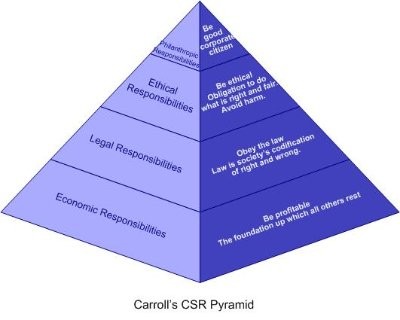According to Carroll (1983), “corporate social responsibility involves the conduct of a business so that it is economically profitable, law abiding, ethical and socially supportive. To be socially responsible then means that profitability and obedience to the law are foremost conditions when discussing the firm’s ethics and the extent to which it supports the society in which it exists with contributions of money, time and talent”. By Carroll’s (1999) own admission, this is only one of countless definitions which have proliferated in the literature since the 1950s. Carroll (1991) organized different corporate social responsibilities as a four-layered pyramid model and called it the pyramid of responsibilities. The four different responsibilities – economical, legal, ethical and philanthropic are the layers of the pyramid.
According to Carroll and Buchholtz (2003), the pyramid of responsibilities should be seen as a whole and the different parts should not be separated. To be profitable as a company, minimize cost and maximize sales or make sensible strategic decisions are at the base of economic responsibilities. Economic performance is required by the society. The second layer is the legal responsibilities and it is also required by society. In these responsibilities companies are expected to obey the law, because the law mirrors show the society regards as accepted or unaccepted. The difference of the ethical responsibilities from the first two responsibilities is that the ethical responsibilities are not required but expected by society. To assert ethical leadership, avoid questionable practices or operate above the minimum standard of the law could be examples for the ethical responsibilities. The philanthropic responsibilities stand at the top of the pyramid and to be a good corporate citizen and improve the quality of life for the society is the aim of these responsibilities. Corporate contributions, to support the community by providing programs or engagement in volunteerism can be example for the philanthropic responsibilities. To some extent the philanthropic responsibilities are desired and expected by the society.

A stakeholder model is represented by the Pyramid of CSR where the different stakeholders are affected by the different responsibilities. If the business is not profitable Economic responsibilities will directly affect employees and owners. Legal responsibilities are vital to the owners, but it is also necessary in the relation with employees and consumer stakeholders. Ethical responsibilities impact on all stakeholders, but most frequently they engage consumers and employees. The major effect of the Philanthropic responsibilities are on the community, but there is also impact on the employees since the company’s philanthropic performance influences the employees’ morale.
Caroll described the following dimensions of CSR
Economic: The first of the dimensions to adopt CSR practices is economic value: entailing a good return on investment for the owners and shareholders, creating jobs and fair pay for workers, and making developments in business.
Legal: The second of the CSR dimensions is legal responsibility: to obey the rules of business and to govern the business according to government legislation.
Ethical: This portrays the dimension of business as being moral and doing just and fair things. Such responsibility is rooted in humanitarian grounds.
Voluntary: This is the dimension where a firm has a wide scope of discretionary behaviors by performing certain activities by which they are actually contributing to the welfare of society.
Further research has elaborated more dimensions of CSR, relating it to strategic HR literature more concerned with the internal employees and direct stakeholders of an organization. The following dimensions of social responsibility have been developed in the HR management (HRM) literature, which is categorized as internal dimensions of CSR.
Nondiscrimination and equal employment opportunity: This dimension is about the organization’s principles on treating the employees on an equal and equitable basis by showing equal opportunity to the talent and promoting diversity.
Staff development and training: The organization’s agenda for employee’s training needs for identifying and developing the talent.
Protection of human rights: To deal with employees on humanitarian grounds and taking care of their health and safety at the work. In addition, providing them with a smooth working environment
Managing environmental impacts: This aspect is about optimization of resource utilization and reducing environmentally damaging effluent can reduce the environmental impact.

